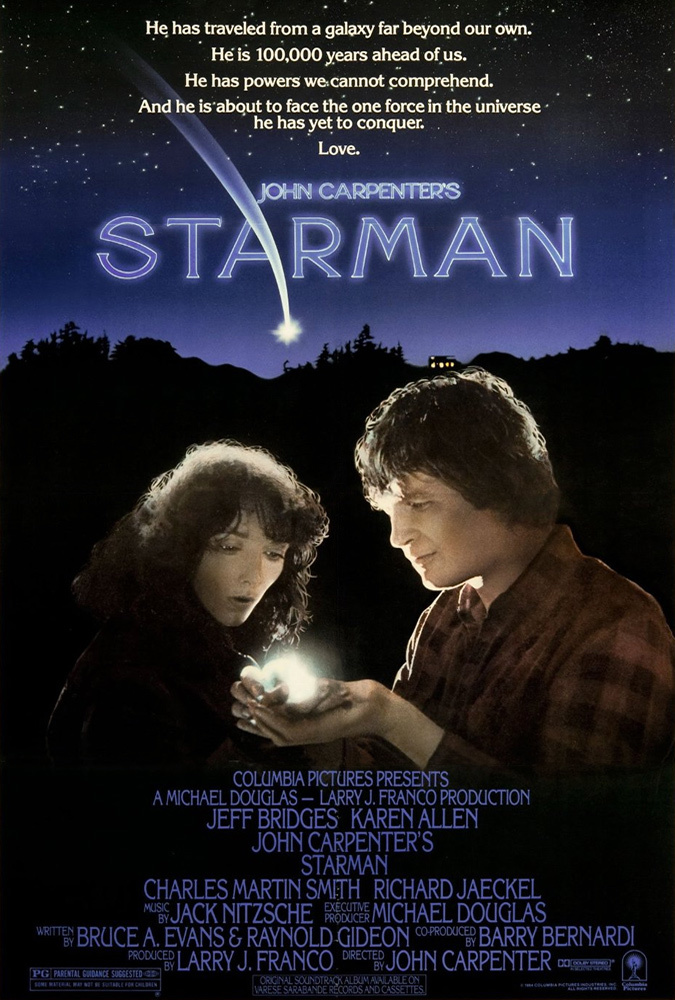 This 1984 film was widely touted as a “change of pace” for John Carpenter. A sweet-minded sci fi romance its director calls “A love song to the Planet Earth,” STARMAN nonetheless contains many recognizable Carpenter touches, including THING-like morphing effects, copious explosions and gore (muted, admittedly, but still evident).
This 1984 film was widely touted as a “change of pace” for John Carpenter. A sweet-minded sci fi romance its director calls “A love song to the Planet Earth,” STARMAN nonetheless contains many recognizable Carpenter touches, including THING-like morphing effects, copious explosions and gore (muted, admittedly, but still evident).
The screenplay, which incorporates elements from Robert Heinlein’s STRANGER IN A STRANGE LAND and Stanislaw Lem’s SOLARIS into an IT HAPPENED ONE NIGHT (1934) inspired framework, was written by Bruce A. Evans and Raynold Gideon (of STAND BY ME and Mr. BROOKS) in the 1970s. The script was purchased by Michael Douglas in 1979 and, following aborted filming attempts by Tony Scott, Adrien Lyne, Mark Rydell and John Badham, was shelved. But after the success of E.T.: THE EXTRA-TERRESTRIAL it was revived as a $20 million John Carpenter project, with Douglas credited as executive producer (and an uncredited script polish by Dean Riesner, who was rewarded for his efforts by a Carpenter-placed dedication in the end credits).
As the film begins the VOYAGER II spacecraft, launched in 1977, enters the orbit of a distant planet. Said planet’s (unseen) inhabitants respond by dispatching an Earth-bound spaceship that’s shot down over Wisconsin, and crash-lands near the home of Jenny Hayden (Karen Allen), a grief-stricken widow. An alien entity, evidently a relative of THE THING’s extraterrestrial shape-shifter, emerges from the crashed pod and uses the DNA in a lock of hair from Jenny’s deceased husband Scott (Jeff Bridges) to morph itself into a clone.
This alien Scott has birdlike mannerisms and halting speech patterns, and Jenny is initially put off by him. He, however, has a handful of marble-like objects capable of affecting supernatural events that help melt her resistance, particularly after the resurrection of a dead deer and the winning of a great deal of money at a casino.
The galvanizing event is a road trip to Meteor Crater, AZ, where Scott’s alien pals are set to land. He has to reach the rendezvous in three days or he’ll die; luckily Jenny has a souped-up 1977 Ford Cobra that’s ideal for cross country driving. Government agents, meanwhile, led by the slimy George Fox (Richard Jaeckel) and the more sympathetic Mark Shermin (Charles Martin Smith), are in hot pursuit.
You might expect Jenny’s relationship with the resurrected Scott to become dark and destructive a la SOLARIS, or for Scott to lead a mass movement a la STRANGER IN A STRANGE LAND, but STARLOG’s screenplay does disappointingly little with its premise. As expected, Jenny warms up to Scott (enough so that she gets impregnated by him), with their exploits helped along by the presence of an Idiot Plot, i.e. a plot that in order to proceed requires its characters to behave like idiots. That’s evident in the actions of the government agents, who despite a thorough canvassing of the country never manage to catch Jenny and Scott (who are somehow able to evade a police roadblock by walking crouched down on the side of a road), with the protagonists facilitating a climactic meeting with the feds themselves by inexplicably stopping off at an Arizona eatery located five minutes from their destination.
It all culminates in a finale that looks quite similar to that of the 1983 science fiction drama WAVELENGTH (whose backers attempted, without success, to sue for plagiarism. The concluding dialogue, furthermore, teases a sequel that never materialized (although a short-lived TV series did in 1986-87).
The film is undeniably well made. Cinematographer Donald M. Morgan, replacing Carpenter’s stock DOP Dean Cundy, keeps his lighting soft, allowing for natural illumination that imparts a more realistic feel than is standard for Carpenter fare. The intricately choreographed tracking shots for which Carpenter is known are largely absent, replaced by a more organic, close up-heavy visual treatment. The actors are certainly game, with Jeff Bridges, in an Oscar nominated turn, delivering one of his most all-around memorable performances, and Karen Allen providing an uncharacteristically haunted and introspective turn that’s about as far removed from RAIDER OF THE LOST ARK’s Marion Ravenwood as it’s possible to get.
There’s also a real sense of affection in Carpenter’s depiction of the rural gas stations and diners, stocked with a colorful assortment of supporting players, at which Scott and Jenny stop during their odyssey. Unlike so many other late Twentieth Century road trip movies (such as THELMA AND LOUISE) that claim to be set nationwide but are filmed entirely in Southern California, STARMAN was actually lensed on location in California, Washington, Nevada and Arizona, and the authenticity of those locations makes all the difference.
Regarding the special effects, created by Dick Smith, Rick Baker and Stan Winston, they were impressive in ‘84 but not so much now. It’s a good thing, then, that the film is character rather than effects centered, and so hasn’t dated too poorly. The same be said for the synthesizer based music by Jack Nitzsche, which emerges as perhaps the finest John Carpenter movie score not accomplished by Carpenter himself.
Vital Statistics
STARMAN
Columbia Pictures
Director: John Carpenter
Producer: Larry J. Franco
Screenplay: Bruce A. Evans, Raynold Gideon
Cinematography: Donald M. Morgan
Editing: Marion Rothman
Cast: Jeff Bridges, Karen Allen, Charles Martin Smith, Richard Jaeckel, Robert Phalen, Tony Edwards, John Walter Davis, Ted White, Dirk Blocker, M.C. Gainey, Sean Faro, Buck Flower, Russ Benning, Ralph Cosham, David Wells, Anthony Grumbach, Jim Deeth, Lu Leonard
